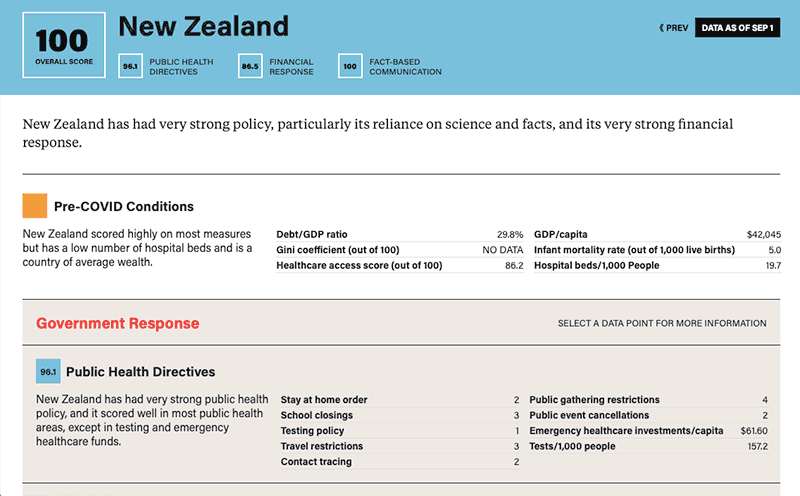The nation was already on the economic brink before COVID-19 hit.
Argentina
- Data as of Aug 1
- Next 》
- 64.4 Public Health
Directives - 26.5 Financial
Response - 100 Fact-Based
Communication
- 64.4 Public Health
Directives - 26.5 Financial
Response - 100 Fact-Based
Communication
Argentina’s strong policy score is mainly due to its strong political response, characterized by clear, fact-based communication and regular press briefings by President Fernandez.
Pre-COVID Conditions
Low availability of hospital beds and a low GDP per capita kept Argentina near the median in its pre-pandemic capabilities.
- Debt/GDP ratio 86.1%
- GDP/capita $19,971
- Gini coefficient (out of 100) 41.4
- Infant mortality rate (out of 1,000 live births) 9
- Healthcare access score (out of 100) 68.4
- Hospital beds/1,000 People 35.8
Government Response
Select a data point for more information(Data points represent policy level as of Aug 1.)
Public Health Directives
Although it passed a strict stay-at-home order on March 19th, closing schools and banning public gatherings, Argentina suffers from limited testing, minimal travel restrictions, and release of less than $1 per capita in emergency healthcare funding.
- Stay at home order 2
- Public gathering restrictions 4
- School closings 3
- Public event cancellations 2
- Testing policy 1
- Emergency healthcare investments/capita $0.58
- Travel restrictions 4
- Tests/1,000 people 0.2
- Contact tracing 2
Financial Response
While Argentina’s stimlus package represents a smaller share of its economy than other countries in our sample, the country has implemented a generous policy targeting debt relief related to COVID-19.
- Financial stimulus as share of GDP 5%
- Income support 1
- Debt forebearance 2
Fact-Based Communication
The Argentine authorities have consistently communicated fact- and science-based information to the public through weekly press briefings.
- Reliance on science/fact based information 0
- Press freedom 0
COVID-19 Status as of Aug 1
Restrictive lockdown rules and clear, regular communication with the public have prevented Argentina’s case rate from skyrocketing, but the country is likely testing only the sickest people, masking the true extent of the disease’s spread.
- Total deaths 3,466
- Death rate per 100K 76.7
- Total cases 185,360
- Cases per 100K 4,101
- Percent of positive tests 41
| Date | Status | New Cases/1M | |
|---|---|---|---|
| 1 | Jul 17 | Some shops, hair salons, professional services reopen; outdoor activities allowed | 76.27 |
| 2 | Jul 31 | Lockdown is extended until August after cases rise | 117.26 |
Differentiating Factors
- Peronism facilitated public compliance: The lasting legacy of Peronism, particularly its popularity among low-income and informal workers, enabled the government to swiftly enact a strict lockdown, aided by its strong centralized government. Governors wishing to lift lockdowns in their states require permission from the President. Read More
- Debt burden hindered financial response: Argentina's historically rocky relationship with the IMF has hindered its ability to respond to the pandemic financially, as it must balance stabilization of its economy and responding to the needs of its citizens with the conditions of its debt restructuring agreement with the Fund. Read More
- Leader's modeled behavior: Political leadership has been key to Argentina's relative success: on June 17 it was reported that President Fernandez would go into voluntary self-isolation following several instances of politicians catching coronavirus. He suspended all travel and in-person meetings, working from the presidential residence to set an example to the public. Read More
Compared with Other Western Hemisphere Countries
-
42.3Brazil 2,662,485
Cases 12,526
Per 1M 92,475
DeathsBrazil has a relatively weak score, primarily due to its poor public health policies, especially its very low levels of testing, coupled with President Bolsonaro’s spreading of misinformation about the virus.
-
41Mexico 424,637
Cases 3,294
Per 1M 46,688
DeathsMexico's score has deteriorated over time, due primarily to its extremely weak financial response and relatively weak public health policy, including very limited testing.
-
27.7United States 4,562,037
Cases 13,783
Per 1M 153,314
DeathsStill battling widespread COVID-19 cases and deaths, which were exacerbated by the former administration's limited use of facts and science, limited emergency healthcare spending, and limited debt relief, the Biden administration, by contrast, is taking aggressive action to combat the virus, although it may take time for the score to reflect these changes.
-
77.7Canada 116,298
Cases 3,081
Per 1M 8,935
DeathsCanada has a relatively strong score, with poor public health policy countered by a continued reliance on fact-based communication.
Further Reading From Foreign Policy
Be the source of actionable insight.
Select one of the subscription options below to read the full Covid-19 Global Response Index. Unlock even more global intelligence with a subscription to FP Insider.
Already an FP Insider? Log In
Looking for group access? Contact us directly

Statistics and government response factors available on each country profile include:
Pre-COVID Conditions:
- Debt to GDP ratio
- Infant mortality rates
- Hospital beds per 1,000 people
- Gini coefficients measuring inequality
- Health access and quality
COVID-19 Public Health Directives:
- Stay-at home orders
- School-closing policy
- Public-gathering restrictions
- Cancellation of public events
- Testing policy and rates per 1,000 people
- Emergency healthcare spending per capita
- Travel restrictions
- Contact tracing
COVID-19 Financial Response:
- Stimulus package as a share of GDP
- Income support
- Debt-forbearance
Public Communications:
- Instances of misinformation by leadership
- Limitations on press freedom, censorship
Current/Historic In-Country COVID-19 Status:
- Death rates per 1 million
- Case rates per 1 million





